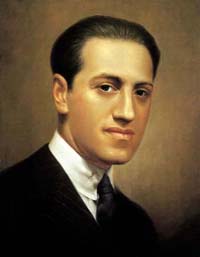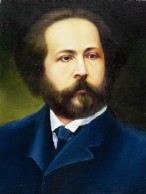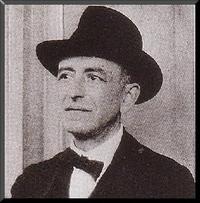| VIVA ESPA—A! | ||||||||||
Cuban Overture In 1924, George Gershwin gained entry into the classical music world with his groundbreaking Rhapsody in Blue. A flood of prestigious commissions followed, including the Concerto in F in 1925 and the Second Rhapsody in 1932. Following the premiere of the Rhapsody, Gershwin and some friends went for a two-week vacation in Havana. Gershwin was fascinated by the small dance orchestras with their novel percussion instruments and exciting, complex rhythms, especially the rumba. He brought home local bongos, gourds and maracas that feature prominently in an Overture he at first wanted to title “Rhumba.” He completed the work in August, just in time for the first all-Gershwin concert at the Lewisohn Stadium in New York, attended by about 18,000 people. According to the composer, “…I endeavored to combine the Cuban rhythm with my original thematic material. The result is a symphonic overture which embodies the essence of Cuban dance.” As his iconic song reminds us, Gershwin was a devote of “fascinating rhythms.” Like any proper Latin dance bandleader, he lays out syncopated melodies in elegant combinations and permutations.  There are classical elements as well in the Overture, particularly Gershwin’s use of contrasting themes and orchestration. There are classical elements as well in the Overture, particularly Gershwin’s use of contrasting themes and orchestration.  One of the themes is a dialogue between oboe and trumpet, the latter’s voice borrowed from south of the border. One of the themes is a dialogue between oboe and trumpet, the latter’s voice borrowed from south of the border.  After a polytonal combination of the themes, After a polytonal combination of the themes,  a languid clarinet solo a languid clarinet solo  ushers in the long, sultry middle section featuring the other upper woodwinds. Gershwin even adds a North American jazz element to the mix – an American in Cuba. ushers in the long, sultry middle section featuring the other upper woodwinds. Gershwin even adds a North American jazz element to the mix – an American in Cuba.  A return to a variant of the opening rumba concludes the piece. A return to a variant of the opening rumba concludes the piece.Sadly, Gershwin died of a brain tumor in 1937, entitling him to membership in the disproportionately large “club” of composers who never saw their 40th birthday. | ||||||||||
Movements I, II, IV & V from Symphonie Espagnole, Op. 21 Edouard Lalo came from a military family in Northern France, his father having fought for Napoleon. Although his parents at first encouraged his musical talent and he studied both the violin and cello, his more serious inclinations towards music met with stern opposition from his father. He left home at the age of 16 to pursue his musical studies at the Conservatoire in Paris. While working for a long time in obscurity as a violinist and music teacher, in 1855 he started a string quartet to popularize the quartets of Haydn, Mozart and Beethoven. It was only in the 1870s that Lalo got a break as a composer. The debacle of the Franco-Prussian war of 1870 and its aftermath created havoc in France’s musical life. However, the rapid reconstruction that followed gave rise to the creation of the Société nationale de musique and the inauguration of three concert series under three great conductors, Jules Pasdeloup, Edouard Colonne and Charles Lamoureux, producing a demand for new works. Young French composers, including Lalo, were inspired to write large-scale orchestral works – like the enormous “history paintings” of Jacques Louis David – although such works had been out of fashion in France at the time. Lalo’s name is primarily associated with a series of works he composed for the Spanish violinist Pablo Sarasate. One of the most spectacular violin virtuosos of the late nineteenth century, Sarasate was known for his beautiful tone, perfect intonation and élan on the stage. He was a striking figure, usually dressed all in black, with a huge ego and a matching flair for publicity. He lived in lavish Paris mansions decorated by James McNeill Whistler in the nineteenth-century equivalent of "Lifestyles of the Rich and Famous". Many composers dedicated works to him, including Max Bruch, Camille Saint-SaŽns, Joseph Joachim, Henryk Wieniawski, Antonín Dvorák, and in particular, Lalo. In 1873 Lalo composed his Violin Concerto, Op.20 for Sarasate and a year later followed up with another work for violin and orchestra, the Symphonie Espagnole, the composer’s most enduring work. Sarasate premiered both with the Colonne Orchestra. Symphonie Espagnole is neither a real symphony, nor a traditional concerto. It is more like a five-movement suite, especially in its incorporation of dance rhythms. But Lalo hated the term “suite,” considering it “a tainted and discredited title.” The Symphonie is French in character, but Spanish in rhythm. What it lacks in musical depth it makes up for in bravura and a wealth of catchy themes. Although the five movements are not named for dances, they all correspond to Spanish dances and folk rhythms, although the structure of the movements corresponds to classical symphonic and concerto models. The first movement is a habanera, with the three themes in the same rhythm – although not the same mood. The first two themes run together, and although the first is little more than a motive, it serves as the glue that holds the movement together as both refrain, and as the most developed musical idea.  & &  The second movement, a seguidilla, is a modified ABA form.  The middle section is almost a recitative for the soloist, with dramatic shifts of tempo. The middle section is almost a recitative for the soloist, with dramatic shifts of tempo.  The third movement, pavane, is a slow dance supposedly related to the gait of the peacock. The movement's slow tempo and minor key suggest a funeral procession. The orchestra introduces the movement's first theme,  which the violin answers with a new theme of its own, which the violin answers with a new theme of its own,  † continuing its lament after a brief orchestral interruption. † continuing its lament after a brief orchestral interruption.  The lighthearted mood of the fifth and final movement breaks the lugubrious spell. The orchestra begins by setting up an ostinato pattern  over which the violin weaves delicate counter melody with elaborate embellishments. over which the violin weaves delicate counter melody with elaborate embellishments.  The movement contains a malagueña in its slower middle section. The movement contains a malagueña in its slower middle section.  | ||||||||||
Suites from El sombrero de tre picos Like so many artists, Manuel de Falla showed not only precocious musical ability, but also facility as a writer. He had a fascination with the Spanish themes and folklore that were to characterize so much of his music. He spent his youth and early career as a pianist and teacher, the proceeds from which helped support his family. In 1905 Falla composed La vida breve, with which he won a contest for a Spanish opera held by the Reál Academia de Bellas Artes de San Fernando. With this opera he elevated traditional Andalusian cante jondo (deep song) to the level of high art. However, the planned performance at the Teatro Reál fell through, and the opera, in a revised two-act form, was finally premiered in France in 1913 and again in Spain in 1914. De Falla realized early on that in order to achieve international exposure for his music, he would have to leave Spain. In 1907 he settled in Paris where he came under the influence of Paul Dukas, Claude Debussy and Maurice Ravel. His music, however, even during the height of the French influence, remained solidly Spanish in style. With the outbreak of World War I he returned to his native country. A deeply religious – almost fanatic – Catholic, de Falla expressed his faith in a magnum opus, Atlántida, an epic based on what he regarded as the holy mission of his boyhood hero Christopher Columbus. The cantata, in which, rising from the ruins of Atlantis, the Spanish nation goes forth under the banner of Christ to the New World, remained incomplete at de Falla’s death. He actually submitted parts of it to Church authorities for approval. Although devout, de Falla was fundamentally apolitical. Initially leaning towards the new Second Spanish Republic in 1931, his intense faith kept him from a complete buy-in with the anti-religious philosophy of the leftists. However, he never answered the call of Franco’s repressive nationalism. In 1939, disillusioned with Spain, and with Europe on the brink of war, he moved to Argentina. Already in frail health and living on an ascetic diet, he died still trying to complete Atlántida. The ballet, El Sombrero de Tres Picos, began life in 1917 as an accompaniment to a two-act pantomime adapted from a popular story by Pedro de Alarcón. Sergey Diaghilev, the impresario of the Ballets Russes, heard the music on a visit to Spain and asked de Falla to expand it into a ballet. It is the story of a miller and his faithful wife, and an aging lothario of a Corregidor (district governor) and his haughty wife. In the story – which would have been a perfect one for a Rossini opera – the Corregidor tries to seduce the miller’s wife; the miller, in revenge, tries to seduce the Corregidor’s wife. It all ends happily, except for the Corregidor who is left looking foolish. The ballet premiered successfully in London in 1919 with set designs by Picasso. De Falla extracted two orchestral suites from the ballet. The first, “Scenes and Dances,” consists of the following scenes from the ballet, although not in the original order: Introduction – Afternoon: The introduction was added in London, to give the audience time to appreciate Picasso’s drop curtain. After an opening fanfare from trumpet and timpani,The second, "Three Dances,” which became the more popular one, consists of the following scenes: The Neighbors’ Dance: The second part of the ballet opens at a St. John’s Day festival around the mill where the neighbors are dancing a seguidilla, a couples dance in triple meter. The score describes the scene as “A lovely Andalusian night, perfumed, starlit and mysterious.” | ||||||||||
| Copyright © Elizabeth and Joseph Kahn 2016 | ||||||||||


